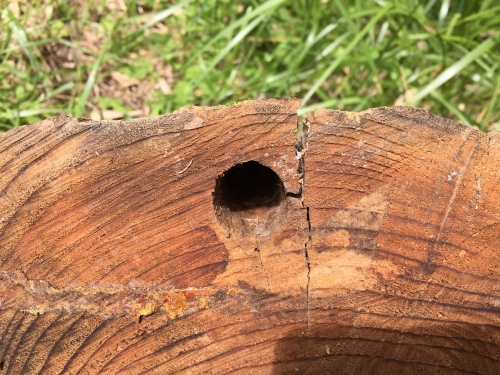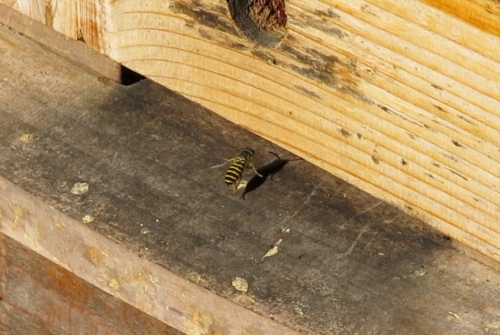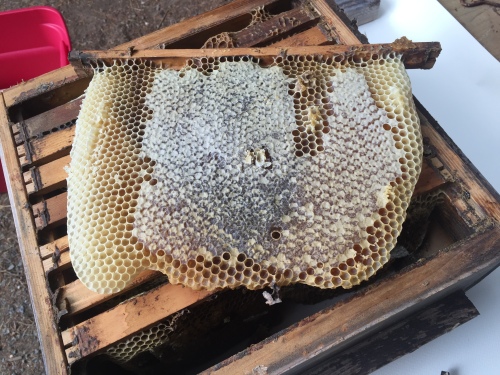2016 has not been a good year for my bees. My ‘end-of-year’ hive status saw four bee hives that had activity. Now I have only one.
After being in denial for a few weeks, I figured I’d face up to the fact this Warré was a goner.

Dec. 25, 2015…I had pulled off the empty top box and pinned some protection from rainwater getting in. It was too late.

Feb. 7, 2016…This is the top box. There was plenty of honey on the four outboard bars, but very little in the middle.
-

-
The two combs in the middle section were mostly empty as can be seen in the photo to the right.
-

-
The few bees that are left are head-first into the cells. I believe that’s a sign of starvation. There was plenty of honey two frames away. Could it be they were too weak that they couldn’t reach the honey bars?
-

-
There’s honey on this bar.
-

-
…and more on this one.
-

-
Dec. 20, 2015…I assumed that bees entering with pollen indicated a laying queen. Yes, there were some dead bees on the screen, but there were also bees removing them from the hive.
Biting the bullet I figured I’d better find out ALL the bad news…and opened up Bee Beard log hive. Somehow rainfall had gotten inside here too, even with the hat and headband. Because of El Niño, we’ve had copious amounts of rainfall. Yes, it’s good for the forests, but not so good for the bee hives.

2-20-16 I pull off Bee Beard’s hat.
Footnote to above…I’d like to make a waterproof ‘hat’ for this hive. If anyone has a suggestion, please pass it on to me.
-

-
A look at the quilt box. SOW BUGS…this can’t be good.
-

-
With the quilt box removed, more sow bugs.
-

-
With top bars pulled off, honey is visible…lots of it.
-

-
Some combs are solid with honey.
-

-
…but these combs are mostly empty.
-

-
Wow…look at that orange pollen.
So why have these hives died back? Could it be the El Niño effect? Record rainfall in December? Ron lost his hives around December. This year I didn’t cover my hives very well. I should have been more careful.
Another thing that’s been bothering me for awhile is the questionable source of swarms I get from time to time. Where are they coming from? I’m beginning to realize they might be coming from the commercial hives in the cranberry bogs. The commercial hives, I just learned from a cranberry grower, come straight up from the almond orchards in California.
These ‘almond orchard bees’ could be infecting my bees and I DON’T GET any payment.

March 25, 2015…..Less than 3 miles (4.8 km) distance away from my bee hives is the staging area for the commercial cranberry hives. These hives are most likely coming from the almond orchards south of us in California. They were being held here prior to being placed in the cranberry bogs. Arrrrgh! Bog bees…”diseased and loaded with mites.”
My wife suggests I ask Bill W. if he sells any Warré nucs. Bill lives inland about 150 miles (241 km). I tell him of my suspicions of commercial hives. His reply…
“Hello Pat,
I don’t have Warré nucs for sale. I get a lot of “bad” swarms also. These are mostly from poorly kept urban high density colonies having bees from poor commercial sources. I pick up a lot of swarms with poor genetics and failing queens. It has caused me to put out more hives and rely upon higher colony failure.
In the Willamette Valley, many commercial beekeepers will keep their colonies here when not busy with almonds or cranberries or something else.
Good luck. -Bill”

The Grand Kids Log Hive is most likely inhabited by “bog bees.” Maybe I should say “was inhabited,” because it’s been silent for almost two months. I thought it successfully superceded, but I’ve not seen any activity since early January.
After assuming my troubles have come from the cranberry “bog bees,” I asked Steve about his bees. We had gotten a swarm of bees, (most likely they were from cranberry hives) last year, May 30th.

Feb. 17….. Steve sent this photo and said…”My bees are fine, but I fed them 50 lbs of sugar in the fall.” Should I rethink feeding sugar to them?
Then there’s Pete’s beehives. I asked him recently about his bees. He is near cranberry bogs too. “They’re doing great. Out flying every non-rainy day, getting into madrone blossoms and other things, possibly even gorse, bringing back all kinds of pollen.”
Bob (of home-built bee vac fame) said his hives were doing fine too. Bob is located near the bogs too. Hmmm, maybe I can’t blame my bee problems on the bogs.

February 23…the Green hive in the tree is the only active one left. The bees are flying in small numbers on sunny days…even bringing in pollen, but again in small numbers. When our willow tree blossomed, I expected to see bees all over it. I was disappointed. Few bees were seen. Maybe it was the almost constant rain.
Since my tree hive seems to have lasted through everything, I decide to try another one. I’ve got to do some trimming around it, but this will be the location for the next one. It’ll hold Warré sized bars, but it’s too heavy to lug around for a bait hive, so I’ll be trying to attract a swarm.

I’ve got to cut back the laurel hedge limb and holly tree. Then I’ll custom fit the hive box between the trunk and the angled limb. I’ve tried it. I think it’ll work.
Bottom line…I think it was the El Niño rainfall. I chose NOT to cover my Warré bee hives this winter. Why not? I didn’t see other beekeepers cover their hives up. I think the difference this year is my observation window covers are slightly warped (outward) Some rain possibly entered there. With so much more rainfall this year than in other years, it was just too much. Somehow the rain got into Bee Beard Log Hive too. I’ll have to work up some kind of ‘head gear’ to shed water. As for the Grand Kids Log hive? I still have to figure that one out. Maybe it WAS a weak, diseased strain of bees from the commercial hives.
Fixing Bee Beard Log Hive…
Read Full Post »




















































































































